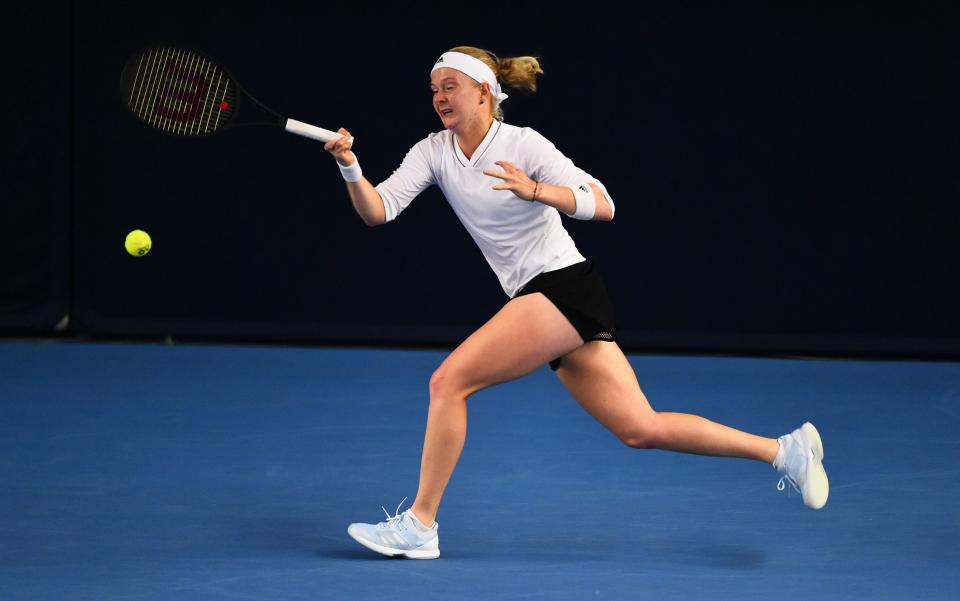Born without three toes and two fingers, Fran Jones defies doctors to qualify for Australian Open

It is hard to think of another player overcoming such disadvantages as the remarkable Fran Jones, the British 20-year-old who has come through qualifying to reach the Australian Open, despite being born with only six fingers and seven toes.
“What an incredible story!” the former world No1 Kim Clijsters wrote on her Twitter page. “Good luck!”
Perhaps the closest parallel to Jones' achievement would be South Korea’s Duckhee Lee, whose ranking peaked at No130 four years ago, despite the deafness that robs him of important information about his opponent’s shots.
Venus Williams and Caroline Wozniacki have both played while suffering from auto-immune conditions, while Alexander Zverev is understood to have dealt with diabetes since he was small. But nothing compares to EED (Ectrodactyly-Ectodermal Dysplasia), the rare genetic condition that altered the formation of Jones’s hands and feet while also leaving her with a cleft palate at birth.
The curious thing is that, without EED, Jones might never have turned to tennis in the first place. As she explained on Tuesday – after her second-round win over Jana Fett in Dubai – it was a doctor’s insistence that she would never reach professional level that had “kicked me into the sport” at the age of eight.
After crushing China’s Jia-Jing Lu by a 6-0, 6-1 margin, Jones was asked if she had proved that unnamed doctor wrong. “I am not bothered about proving people wrong,” she replied. “I’d rather prove to people that you can – and switch the perspective there.
“The first one is out of revenge and I am not playing out of revenge. I am playing to have a positive impact on the people who hopefully read my story. I do hope people can take some… I don’t want to say tips, because I am not one to give tips either. But I’d love people to take strength from my story to build their own.”
At just 20-years-old, Jones already speaks like a woman with enormous life experience. During Wednesday’s press conference, she was asked whether she had ever been tempted to feel sorry for herself. The answer was no.
“I think it was all I knew,” she said. “I had phenomenal parents [Simon and Adele, a pair of financial advisors] who just guided me through each step. I wouldn't feel sorry for myself and I don't think people should.
“Each person is dealt their set of cards,” added Jones, who will climb at least 20 places from her current ranking of No241. “If you are dealt a full house straightaway, fair play to you. But if not, then you need to find a way to win the game with another strategy and that's what I'm doing. I have my cards, I'm trying to learn how to play the game, and I've still got a lot more to learn.”
So what are the practical consequences of playing tennis with EED? Jones’s grip on the handle is affected by her small hands, necessitating a lighter racket than most professionals. She also has to be especially disciplined in her physical preparation, for injuries are a constant threat.
Since attending Barcelona’s Sanchez-Casal Academy from the ages of nine to 16, she has been one of the Lawn Tennis Association’s supported players. But she is still based in Spain, along with the rest of her team – coach Andreu Guilera, assistant coach Jordi Samper and physio Roberto Vavassori.
“My challenge has been to put myself in a physical shape that prevents injuries,” she explained. “My feet work in a different way and that means I run differently. My balance goes through my feet in a different way, through my toes in a different way.
“I’ve always had a really, really small grip and a light racket and I’m hesitant to change that because it has worked well so far. In the gym, I have spent a lot of time trying to gain strength to support the… I don’t want to say deficiencies, but just the weaknesses that I may have. I think every human being has physical weaknesses unless you're Cristiano Ronaldo or something.”
Jones rang home after Wednesday’s fine performance but said she could hardly hear anything but crying, screaming and the dog’s barking. “It was quite an emotional call because obviously we've gone through a lot together and I left the UK at nine. You miss out on a lot of experiences with your parents and that's hard on all of us.”
She expects to fly to Melbourne on Friday, via one of Tennis Australia’s charter planes that are to hold no more than 75 people in their 300 seats. Don’t expect to see her post any photographs on social media, though, as she has doesn’t even have any active accounts. She prefers to keep a lower profile than some of her peers, who often seem more concerned about looking glamorous on Instagram than they do about winning matches.
“To me, social media is a platform that can be used to your benefit,” she said. “But I also think at the moment it has a negative influence on society. I don’t want to get too caught up in it. I like to stick to the tennis and to my life and I quite like my privacy in that respect.”
It is quite the lesson. Rather than allowing her unique challenges to define her, Jones is maximising everything she has, while paying no attention to fripperies. She clearly recognises what is and isn’t important – a skill that has surely been honed by her rare condition. A few other young wannabes could learn from her example.

 Yahoo Sport
Yahoo Sport 





































